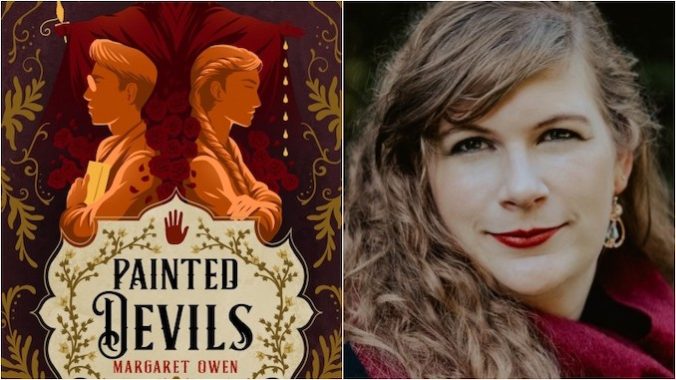Margaret Owen Breaks Down Painted Devils, Vanja’s Journey, and What to Expect From Her Trilogy’s Final Chapter

It’s possible that Margaret Owen is one of the most underrated authors in the world of YA fantasy today. Personally speaking, I’ve been obsessed with her books since her debut The Merciful Crow dropped in 2019, and her writing is consistently full of the best things about this genre: Complex, messy characters; unique influences from the world of folklore and mythology; propulsive, and unexpected stories grounded firmly in the emotional journies of the unconventional heroines at their centers.
Painted Devils is the second installment in Owen’s Little Thieves trilogy, the story of a scrappy jewel thief and con artist adopted by the gods Fortune and Death who is struggling to figure out where she belongs. The story includes everything from an accidental cult and fake gods to big-picture questions about the nature of family, and how to navigate the physical and emotional intimacies that come along with falling in love.
Irreverent, entertaining, and surprisingly thoughtful about the ways our most satisfying relationships are those that ultimately help us grow into our best selves, it’s a series that’s full of surprises, and one that people should make time to discover this summer.
We got the chance to chat with Owen herself about her Little Thieves sequel, Vanja’s feelings of inadequacy, the folklore that inspired some of her story, and lots more.
![]()
Paste Magazine: I feel like I say the same thing every time I talk to you about your work, but I loved everything about Painted Devils, and reading it was a complete delight. Tell us a little bit about how this story came into being—did you know going into Little Thieves that it would have a sequel and what were you most trying to accomplish with this next installment of Vanja’s journey?
Margaret Owen: Thank you so much! I approached Little Thieves as a standalone, but at about the two-thirds mark of the first draft, I knew I could write dozens of books about these characters—and that Vanja had issues the first book could only start to address. I pitched more books to my editor at the time, and I’m so glad she was able to get my publisher to agree to a trilogy!
With this installment, we dive deeper into Vanja’s backstory and why she is the way she is; we get into the reality of how hard it is to put your trust in someone new when time and time again, people you’ve trusted have abandoned you. I also wanted to surgically deconstruct the construct of virginity, and illustrate how it’s been weaponized against adolescents at large, but particularly queer youth, and especially asexual-spectrum kids. Time will tell if I pulled it off!
Paste: Talk to me about where we find Vanja in this book. Her behavior at the beginning of the story—her decision not to go to and meet Emeric—has huge consequences for her and their relationship, but could also in many ways be read as a step backward for her character. How did we (and she, really) get from the end of Little Thieves to the start of Painted Devils?
Owen: Vanja’s always been a bit of a two steps forward, one step back character, and it’s because the wounds she has are not ones that can be healed in one step. Being romanced doesn’t heal her insecurity, it transmutes it from “I am not worthy of love” to “I will inevitably be abandoned.”
In the beginning of Painted Devils, she’s starting to see the edges of the sinkhole, as it were; she doesn’t feel like she has much to offer, and that means she can’t be Emeric’s equal in their relationship. I think a lot of her choices in Painted Devils can be traced to how we see her act when she’s afraid she’s becoming a burden.
-

-

-

-

-

-

-

-

-

-

-

-

-

-

-

-

-

-

-

-

-

-

-

-

-

-

-

-

-

-

-

-

-

-

-

-

-

-

-

-








































